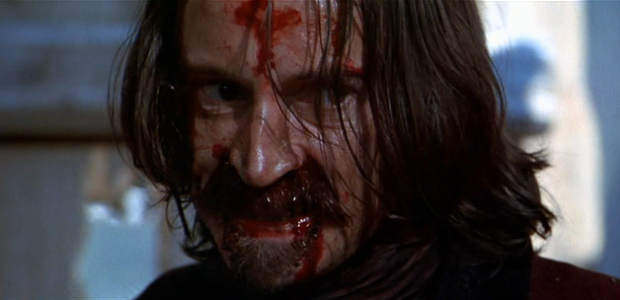It’s no secret that I’m a “late bloomer”, so to speak. Growing up in a strict environment, where everybody is cishet, where nobody ever talks about sex, gender, or (heaven forbid) even their feelings, affects a person. Is it any wonder that I grew up to be just a little repressed about these topics? I didn’t come to terms with my sexuality until I was in my twenties. I didn’t begin to realize my gender until I was turning thirty.
Finally moving away from that place, happily married and building a life for myself, allowed for chances at self-reflection. I would see elements of myself in media for the first time: in books, in songs, and especially in movies; and there’s one movie in particular that has been pivotal in my self-realizations: RAVENOUS (1999). This film has become incredibly important to me. Since discovering this movie far too late into my life, I’ve watched it a ridiculous number of times, and it now defines the concept of “comfort viewing” for me. RAVENOUS helped me figure out that I am bi/pan, and helped me figure out that I am non-binary; and today, I’m going to finally talk about how the film helped me come to these realizations.

RAVENOUS is a dark comedy horror western about cannibalism and the wendigo legend. The harsh backdrop of the frozen Sierra Nevada makes for a brutal and barren landscape where the characters are the only warmth. This means that, as viewers, we huddle closer to them for that warmth: we attach ourselves to them and their well-being, because without them we would be lost in the snow. Initially the film appears to focus only on taking down tropes of toxic masculinity. The protagonist John Boyd (Guy Pearce) is a coward, a decorated “war hero” who hid among the dead in order to survive. The rest of Boyd’s comrades are mostly ineffectual soldiers, whether they be overly pious, bored faux-intellectuals, drunks, or drug addicts. Private Reich (Neal McDonough) stands out in this takedown of toxic masculinity as the rage-filled definitive soldier. Angry and warlike, he is introduced standing naked in the waist high freezing river screaming his rage for the wilderness.
Yet it’s Reich’s nakedness that is the first hint of what becomes the true underlying current of the film. RAVENOUS, in reality, is an erotic horror– a gay erotic horror, to be specific. And at the core of the story is the relationship between Boyd and Ives (Robert Carlyle).
Ives is a wendigo, a man transformed into a monster by the eating of human flesh. He is powerful, nearly indestructible, and he wants Boyd to join him. The film is filled to the brim with powerful homoerotic imagery. Whether it’s Carlyle’s Ives seductively licking the blood from his own fingers, or two men being pressed together in their death throes. There are constant verbal and visual references to the joy and power of one man taking another into himself. While the film explores this in the form of man taking another man as food, it’s hard to miss the subtext here. The main narrative is Ives very literal seduction of Boyd, and (through Boyd) the audience too.
It was during one particularly dark and flirty exchange between Boyd and seductive Ives, that this repressed twenty-something started to notice something. “Hang on,” I would think, “am I finding Ives attractive?” Much self-reflection, a few rewatches, and finally having something to tell my therapist later, and I am happily able to admit that I am bi/pan today. RAVENOUS opened the door and set me on that path of self discovery and happiness. Yet it wasn’t the only time that it did this. RAVENOUS didn’t only help me realize my sexuality.
Fast forward to much more recently, to the last couple of years to be precise, and my identity crisis isn’t as quite fully resolved as one would hope. Yes, I am out to everyone I care about, but something doesn’t sit quite right in my heart. It is time for some comfort viewing – let’s watch RAVENOUS again.

All of the homoeroticism is still there, and I still get joy from it, but this time around there is something else. Another important element of the film is the transformative nature of embracing your true nature. If Boyd embraces becoming a wendigo, he will be happy and healthy. Ives explains how by allowing himself to change he has never been sick again, including his mental health. He literally has not been depressed since. Yet there is an implication running through Ives narrative that this transformation is an embrace of his true nature. Ives is the wendigo, he always was, and he believes Boyd is too.
The concept of allowing yourself to be who you truly are, that you can change into your true self, is what lead me down a second long path of self-discovery that the film opened for me. It was thanks to this film that I started talking to several of my trans friends, who were willing to share their experiences with me. And as a result of this film and those conversations, I was able to realize that I am non-binary and embracing who I truly am is a path to happiness. Even if not everyone around me is going to agree with that change.
Twice now RAVENOUS has opened my soul, and helped me to find myself and my happiness. Hopefully it can do that for others too.


No Comments